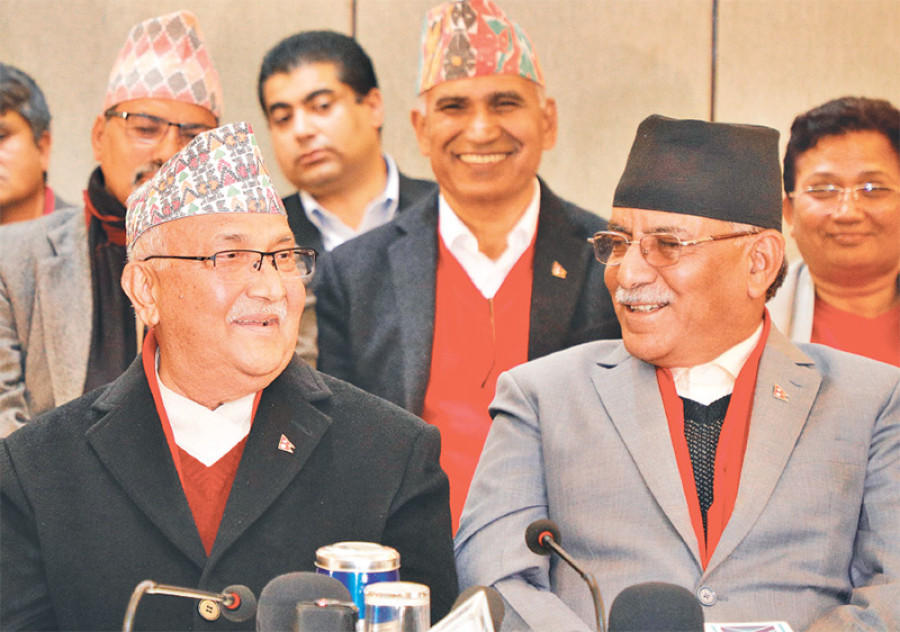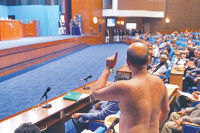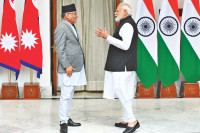Special Supplement
Love-hate couple
People were in a festive mood during the last week of September. There was a long public holiday due to the Dashain festival, and leaders of major parties were taking a break from political meetings. However, CPN-UML Chairman KP Oli and CPN (Maoist Centre) Chairman Pushpa Kamal Dahal were engaged in intense closed-door negotiations to explore the possibility of forming an electoral alliance with the ultimate aim of unifying the two parties.
Kamal Dev Bhattarai
People were in a festive mood during the last week of September. There was a long public holiday due to the Dashain festival, and leaders of major parties were taking a break from political meetings. However, CPN-UML Chairman KP Oli and CPN (Maoist Centre) Chairman Pushpa Kamal Dahal were engaged in intense closed-door negotiations to explore the possibility of forming an electoral alliance with the ultimate aim of unifying the two parties.
Meanwhile, Prime Minister Sher Bahadur Deuba was resting at his official residence at Baluwatar after having taken ill. Some of his close aides were advising him to prevent a possible coalition between Dahal and Oli.
Deuba, however, was not convinced that his colleague Dahal would team up with Oli, consequently he did not take the advice seriously. He was also clueless that Home Minister Janardhan Sharma was working to make the Left Alliance happen. When Deuba phoned Sharma and asked him about the coalition, Sharma, who projects himself as the choreographer of the Left Alliance, told Deuba that the Maoist party was indeed going to forge an electoral alliance with the UML.
Following the end of the Dashain holidays, Oli and Dahal announced the formation of the alliance. This was one of the most headline-grabbing events of 2017 with long-term ramifications for the country’s political landscape.
Many people found the news of the electoral alliance and eventual party unification hard to believe because they were so used to hearing that the Nepali Congress (NC) and the Maoists would continue their partnership for the next five to 10 years. It was a surprise even for the leaders and cadres of the two parties who were not privy to the developments. Without any discussion at the party’s formal platforms, the two leaders decided to forge an electoral alliance and sold it to their respective party rank and file.
As there had been bad blood between Oli and Dahal for years, the announcement of the Left Alliance with the ultimate purpose of party unification exhibited surprising rapport and was unbelievable to some extent. And naturally, the announcement, which was made in October 3, grabbed national and international headlines.
The development drew much attention due to a couple of reasons.
The history of communist parties in Nepal is a history of fragmentation, and this was the first time that two big mainstream political parties had come together with the slogan of peace and prosperity.
This had a direct impact on the results of the House of Representatives and Provincial Assembly elections. The alliance had been formed ahead of the important national elections with the aim of securing a majority vote to form a new government. This is why the alliance drew the attention of the international community, particularly from India and China. Now, the two parties have achieved popular mandates to lead the government for at least the next five years.
Relations between Oli and Dahal were never cordial, except for a few months when they formed a coalition government in 2015. Their relations hit a low point when Dahal withdrew support for the Oli-led government, leading to its downfall. The ties further soured due to a dispute that arose when vote counting in Bharatpur was disrupted after Maoist representatives tore up the ballot papers. In the subsequent re-election, Dahal’s daughter Renu Dahal emerged victorious by defeating UML candidate Devi Gywali who had a good chance of winning if the ballot papers had not been destroyed.
Oli has never been positive towards the Maoist party and its chairman Prachanda since the inception of the peace process in 2006. The then UML general secretary Madhav Kumar Nepal was actively involved in bringing the Maoists into mainstream politics. However, Oli was not so enthusiastic about the idea. Relations between the conservative, harsh-speaking and resolute Oli and the progressive and unstable rival party leader Dahal are widely seen as an odd-couple chemistry. But both have one thing in common: Strong command over the party’s organisational structure and the capacity to take bold decisions and implement them.
Dahal has criticised Oli for not being committed to republicanism and federalism. Oli, on the other hand, has been a vocal critic of the Maoist insurgency and its leaders. Oli took a hard position on issues related to the integration of Maoist combatants and the peace process. The two leaders also hold divergent views on issues related to Madhes, Janajatis and other constitutional matters. There is still a profound ideological difference between the two leaders. Due to these reasons, the electoral alliance was a total bombshell.
At the same time, there are some compelling reasons why the top leaders of the two communist parties found common cause for the alliance. The Indian blockade was a turning point which brought the two leaders together on the issue of ‘nationalism’.
“This is the first issue which brought the two leaders on the same page. Both firmly stood against the Indian blockade, but other parties held a wavering position on the Indian blockade,” said political analyst Shyam Shrestha. On the issue of nationalism, both leaders thought that they could work together despite their several differences. The two have an almost similar position with regard to policy towards India. They want to scrap the 1950 Peace and Friendship Treaty and replace it with a new one. The only difference is that Oli has publicly criticised India on several issues while Dahal has remained silent.
Though there are deep ideological differences between the two leaders, there is convergence on several tactical issues. Both the UML and the Maoist Centre have embraced parliamentary democracy and social democracy. Both parties share the same constituencies–left voters—and they see each other as competitors. That is why the two leaders concluded that if the two parties contest the election separately, the NC will take the benefit. The duo believed that the two parties share the same constituencies, but the NC maintains its own constituency.
At the same time, Dahal concluded that an electoral alliance with the NC would not bear fruit due to its internal dynamics. Despite repeated talks, the NC and the Maoists failed to forge an understanding. On the other hand, Oli was desperately working to break the NC-Maoist partnership. Oli’s calculation was that if there was an NC-Maoist alliance, the party would have to remain out of power for the next five years. This is also linked with the personal ambitions of Dahal and Oli. Oli’s desire was to ascend to power, but he was not convinced that his party would receive a single-party majority. Dahal, on the other hand, was dreaming of reviving his party’s lost power. Dahal took Oli’s offer of a 60:40 sharing of seats as an attractive package.
Similarly, the two leaders felt that they alone could not contribute to the development and prosperity of the country. “After the promulgation of the constitution, both leaders were seeking an opportunity to do something for the development of the country. However, they were not in a position to do something alone. They concluded that only a combined effort could bring change. That is why they decided to walk together,” said Maoist senior leader Narayan Kaji Shrestha who worked hard to bring the two parties together. “Political issues had already been settled with the promulgation of the new constitution, so the two leaders thought getting together was the best way to fulfil their dreams and ambitions,” he added. “The Left Alliance paved the way for peace and development with a strong government with more stability,” he said.
The results of the local level polls served as a catalyst for both leaders to forge an electoral alliance. Before the local elections, Oli was more aggressive towards the Maoist party and its chairman Dahal. Oli’s calculation was that the Maoist party was very poor and would not fare well in the local elections. Oli even went on to say that the Maoist party would not exist after the local polls.
For Oli, an alliance with the Maoist party was necessary to form a government after the House of Representatives and Provincial Assembly elections. For Dahal, an electoral alliance was necessary to further improve the party’s showing in both the houses. The alliance has been further consolidated after the election results. The Left Alliance has secured a comfortable majority required to form a government.
Many issues relating to party unification remain unsettled but both leaders seem committed to forming a stable government. The issue of party unification is a long-pending issue. Senior UML leader Bam Dev Gautam has been continuously taking up the issue of party unification with the party leadership. From the Maoist party, its senior leader Narayan Kaji Shrestha has been pushing for the same.
As it is, the Left Alliance has been successful in its mission. However, it is not sure that there will be party unification, and that both Oli and Dahal will be in the driver’s seat. Much will depend on the power-sharing arrangement between the two parties. Leaders from both parties confess that it is not easy to go for party unification as there are several hurdles.




 20.12°C Kathmandu
20.12°C Kathmandu










